|
|

|
REPORTS ON
ADMINISTRATIVE AND BUDGETARY MATTERS: CBD Executive Secretary Hamdallah
Zedan introduced the report on the administration of the Convention
and the budget for the Convention's trust fund (UNEP/CBD/COP/5/9),
noting that it details the status of the CBD Secretariat's budget
since COP-4, the three trust funds, implementation of the host government
agreement and contributions to the voluntary trust fund. Regarding
the proposed budget for the biennium 2001-2002 (UNEP/CBD/COP/5/18
and UNEP/CBD/COP/5/18/Add.1), he noted that it incorporates the
financial implications of the numerous recommendations to the COP
adopted by intersessional meetings, and builds on the Secretariat's
existing activities
 Real Audio: Part
one Part
Two
Real Audio: Part
one Part
Two
|
|
|
Working
Group One: Sustainable Use and
Incentives
|
 LATVIA, on behalf of the CEE, highlighted the involvement of
stakeholders and incorporation of CSD outcomes on tourism
LATVIA, on behalf of the CEE, highlighted the involvement of
stakeholders and incorporation of CSD outcomes on tourism |
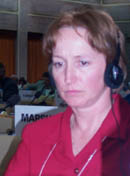 |
|
|
 BRAZIL emphasized the need to: develop synergies between conservation
and sustainable use as per CBD Article 10; involve the private sector
in sustainable use; support and better define sustainable ecotourism;
and delay premature proposals for coordinating initiatives on incentives.
BRAZIL emphasized the need to: develop synergies between conservation
and sustainable use as per CBD Article 10; involve the private sector
in sustainable use; support and better define sustainable ecotourism;
and delay premature proposals for coordinating initiatives on incentives. |
|
|
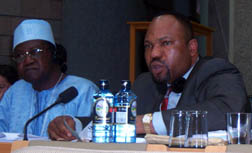 |
 The NETHERLANDS supported a joint programme work with the OECD
and IUCN on
The NETHERLANDS supported a joint programme work with the OECD
and IUCN on
incentives and suggested that linkage between sustainable use and
incentives be directed to specific sectors.
|
|
|
 TONGA highlighted the challenges faced by small island developing
states regarding incentives for sustainable ecotourism
TONGA highlighted the challenges faced by small island developing
states regarding incentives for sustainable ecotourism |
|
WG-II
Bureau, chaired by Peter Shei (far left) in a huddle discussing
the redraft of text on sustainable use.
|
 |
|
|
Working
Group Two: Access and Benefit Sharing
|
|
|
WG-II
Chair Elaine Fisher (Jamaica) opened deliberations on access to genetic
resources, and the Secretariat introduced the relevant documents (UNEP/CBD/COP/5/4,
8 and 21). |
 INDIA highlighted the need for legislation and control measures
in resource-user countries to complement legal measures in resource-provider
countries. He also highlighted the issue of IPRs, and endorsed the
recommendation to further explore the compatibility of the Agreement
on Trade Related Aspects of Intellectual Property Rights (TRIPs)
and CBD objectives.
INDIA highlighted the need for legislation and control measures
in resource-user countries to complement legal measures in resource-provider
countries. He also highlighted the issue of IPRs, and endorsed the
recommendation to further explore the compatibility of the Agreement
on Trade Related Aspects of Intellectual Property Rights (TRIPs)
and CBD objectives. |
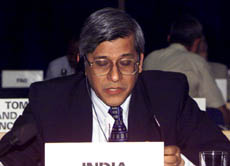 |
|
|
 NORWAY noted connections with COP discussions on agrobiodiversity
and Article 8(j) and suggested a comprehensive approach allowing the
CBD to play a proactive role within other relevant international fora.
NORWAY noted connections with COP discussions on agrobiodiversity
and Article 8(j) and suggested a comprehensive approach allowing the
CBD to play a proactive role within other relevant international fora.
|
 Portugal, on behalf of the EU, called for creating national
focal points to indicate from whom PIC in required. He also supported
finalizing negotiations of the International Undertaking on Plant
Genetic Resources by the end of 2000 in the form of a legally binding
instrument.
Portugal, on behalf of the EU, called for creating national
focal points to indicate from whom PIC in required. He also supported
finalizing negotiations of the International Undertaking on Plant
Genetic Resources by the end of 2000 in the form of a legally binding
instrument.
|
 CANADA emphasized the need to improve flow of benefits and to
insure that ABS arrangements foster in situ conservation
CANADA emphasized the need to improve flow of benefits and to
insure that ABS arrangements foster in situ conservation
|
 BRAZIL questioned the approach within the FAO to renegotiating
the International Undertaking on Plant Genetic Resources (IU), and
suggested that the issue be addressed under the CBD.
BRAZIL questioned the approach within the FAO to renegotiating
the International Undertaking on Plant Genetic Resources (IU), and
suggested that the issue be addressed under the CBD. |
 |
|
|
 SWITZERLAND stressed broader participation and suggested a rapid
start to developing international guidelines.
SWITZERLAND stressed broader participation and suggested a rapid
start to developing international guidelines. |
|
|
Side event: The Convention
on Biodiversity and the WTO
|
Solagral,
Les Défis d'un Monde Solaire, hosted a panel discussion on the
relationship between the CBD and the WTO.
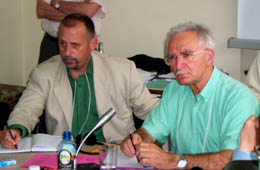 Bernard
Roussel, Muséum National d'Histoire Naturelle de France [top
photo, left], moderated discussions which focused on financial
benefits and access regarding patenting and national sovereignty
over genetic resources. Attention also revolved around the similarities
and differences between developing and developed country farmers
positions. Bernard
Roussel, Muséum National d'Histoire Naturelle de France [top
photo, left], moderated discussions which focused on financial
benefits and access regarding patenting and national sovereignty
over genetic resources. Attention also revolved around the similarities
and differences between developing and developed country farmers
positions.
Yves Manguy,
Coordination Nationale pour la Défense des Semences Fermières
[top photo, right], described his institution's legal cases
against Norvartis, Bayer and Agrévo for refusal of sale and discriminatory
agreements. He outlined the problems faced by French farmers with
increased control of agribusiness companies over IPR on seeds
and highlighted the strategies seed companies to: misinform the
public about GMOs; promote plant breeding patents and IPR systems;
and develop terminator and plant gene expression biotechnologies
holding great risks to human health and biodiversity.
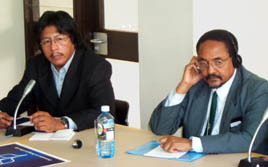 Tewolde
Berhan Gebre Eghziabher, Ethiopia [second photo, right],
discussed legislation developed by the Organization of African
Unity regarding intellectual property rights, indigenous peoples
and local communities. He noted pressures on local farmers derived
from the monetization of African economies, socioeconomic and
land tenure changes and state centralization. He said that the
community level ought to be the starting point for IPR and biodiversity
legislation. Regarding existing IPR regulations contained in the
Agreement on Trade-Related Intellectual Property Rights, he stressed
that there should be neither patents on living organisms, including
micro-organisms nor patents on life processes, as they do not
incorporate an inventive step. Tewolde
Berhan Gebre Eghziabher, Ethiopia [second photo, right],
discussed legislation developed by the Organization of African
Unity regarding intellectual property rights, indigenous peoples
and local communities. He noted pressures on local farmers derived
from the monetization of African economies, socioeconomic and
land tenure changes and state centralization. He said that the
community level ought to be the starting point for IPR and biodiversity
legislation. Regarding existing IPR regulations contained in the
Agreement on Trade-Related Intellectual Property Rights, he stressed
that there should be neither patents on living organisms, including
micro-organisms nor patents on life processes, as they do not
incorporate an inventive step.
J.A. Charles,
Fédération des Organisations Amérindiennes de Guyanne [second
photo, left], discussed threats to the traditional knowledge
and territories of indigenous peoples within French Guyana. He
suggested that IPR are "colonialist" and deprive indigenous peoples
of their knowledge and resource systems. He called for the development
of sui generis systems to protect traditional knowledge
and collective property rights, the reinforcement of customary
management systems and recognition of such systems within developed
countries.
For more
information: [http://www.envirodev.org/]
[http://www.solagral.org/]
[solagral.mpl@solagral.asso.fr]
|
|
|
Side event: Millennium Ecosystem
Assessment
|
|
Walt
V. Reid [waltreid@attglobal.net],
Acting Science Director of the Interim Millennium Ecosystem Assessment
Secretariat, World Resources Institute convened a workshop on the
Millennium Ecosystem Assessment (MEA) initiative endorsed by UN
Secretary General Kofi Annan. The MEA is being developed to strengthen
capacity to manage ecosystems for human development and contribute
sound scientific input and baselines for developing biodiversity
policy.
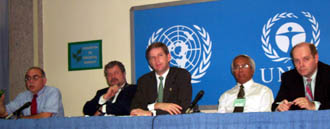 Cristian
Samper, Instituto Alexander Von Humboldt, Columbia and Chair of
SBSTTA-5 [center] facilitated discussion and introduced speakers
which are members of the MEA Steering Committee. He highlighted
the unique elements of the MEA: integration of users in design;
cross-sectoral linkages for biodiversity; the integration of international
and national scales; the mobilization and capacity building of policy
relevant scientific knowledge beyond information gathering. Cristian
Samper, Instituto Alexander Von Humboldt, Columbia and Chair of
SBSTTA-5 [center] facilitated discussion and introduced speakers
which are members of the MEA Steering Committee. He highlighted
the unique elements of the MEA: integration of users in design;
cross-sectoral linkages for biodiversity; the integration of international
and national scales; the mobilization and capacity building of policy
relevant scientific knowledge beyond information gathering.
H.
Zakri, Universiti Keangsaan Malaysia and SBSTTA-4 Chair [second
from the right], said the MEA would focus on regional and national
capacity building regarding how changes to ecosystems will affect
their ability to meet human demands for goods and services. The
ecosystem approach aims to address linkages and tradeoffs between
various sectors including timber, water, biodiversity, agriculture,
fisheries, health and carbon.
Daniel
van R. Claasen [dclaasen@unep.org,
second from the left], Acting Director of UNEP Monitoring and
Assessment Programme, emphasized UNEP's comparative advantage in
integrating and exchanging such ecosystem information.
Mario
Ramos [mramos@worldbank.org,
far left], GEF Secretariat, emphasized the extensive political
support of potential MEA users, including GEF financial support
and interest in ecosystem baselines in order to assess the impact
of its US$ 1 billion investment in 360 biodiversity projects.
Anders
Alm [far right], CBD Secretariat, said that SBSTTA-4 had
requested development of mechanisms for scientific assessments to
inform CBD operations and SBSTTA-5 had requested CBD Secretariat
consultation with the MEA Steering Committee.
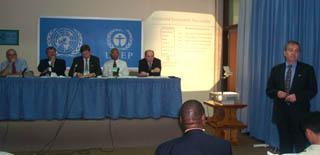 Klaus
Töpfer, UNEP Executive Secretary [standing, on the right],
emphasized UNEP's leading role in coordinating the MEA as an alternative
approach to avoid duplication, integrate experts in a manner to
overcome bottlenecks and enhance developing country capacity structures
in ecosystem assessments. Klaus
Töpfer, UNEP Executive Secretary [standing, on the right],
emphasized UNEP's leading role in coordinating the MEA as an alternative
approach to avoid duplication, integrate experts in a manner to
overcome bottlenecks and enhance developing country capacity structures
in ecosystem assessments.
The
subsequent question and answer centered on: MEA ownership and whether
it was top-down or bottom-up; if vegetation rather than timber was
a more appropriate ecosystem sector; the differences between the
ecosystem approaches of the GEF operational and CBD work programmes
as opposed to the MEA integrated ecosystem approach the institutional
make-up and modus operandi of the MEA; if and how to integrate social
science information on human demands for biodiversity goods and
services in the MEA; how to involve with national and sub-regional
CBD coordinating bodies and focal points; and the level of detail
for synthesizing and generating new information rather than data.
For
more information: [http://www.ma-secretariat.org]
|
|
|
Side event: GEF Biodiversity
Enabling Activities
|
 Ramesh
Ramankutty [rramankutty@worldbank.org],
Monitoring and Evaluation Specialist, Global Environmental Facility
(GEF), presented an interim assessment of the biodiversity enabling
activities supported by the GEF. Completed for the GEF Council, the
assessment shows investments totaling US$ 24.8 million in 121 countries,
including US$ 21.7 million for 117 enabling activity projects approved
for up to $350, 000 in 1996 alone using expedited GEF procedures.
In some countries, national biodiversity strategies and action plans
produced have been comprehensive, cross-sectoral in nature involving
solid technical input and in-depth stakeholder consultation. In contrast,
other countries enabling activities have experienced significant start-up
delays, have not consulted widely and seem to be developing action
plans consisting mainly of projects further international funding.
Very few countries have starting implementing their action plans. Ramesh
Ramankutty [rramankutty@worldbank.org],
Monitoring and Evaluation Specialist, Global Environmental Facility
(GEF), presented an interim assessment of the biodiversity enabling
activities supported by the GEF. Completed for the GEF Council, the
assessment shows investments totaling US$ 24.8 million in 121 countries,
including US$ 21.7 million for 117 enabling activity projects approved
for up to $350, 000 in 1996 alone using expedited GEF procedures.
In some countries, national biodiversity strategies and action plans
produced have been comprehensive, cross-sectoral in nature involving
solid technical input and in-depth stakeholder consultation. In contrast,
other countries enabling activities have experienced significant start-up
delays, have not consulted widely and seem to be developing action
plans consisting mainly of projects further international funding.
Very few countries have starting implementing their action plans.
For more information: http://www.gefweb.org/
|
IN
THE BREEZEWAYS
 As delegates launched into discussions on access to genetic resources,
many noted linkages with other international fora currently under
review. Some participants pondered how the ongoing TRIPS review,
particularly on biodiversity-related issues, and the beleaguered
renegotiation of the International Undertaking would impact and
be impacted by COP-5's decisions.
As delegates launched into discussions on access to genetic resources,
many noted linkages with other international fora currently under
review. Some participants pondered how the ongoing TRIPS review,
particularly on biodiversity-related issues, and the beleaguered
renegotiation of the International Undertaking would impact and
be impacted by COP-5's decisions.
Right:
at the UN compound at Gigiri, buildings are not separated
by closed corridors, instead they are linked by open breezeways.
|


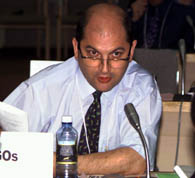
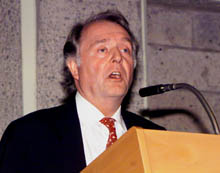


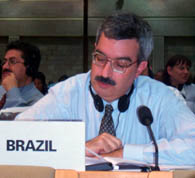

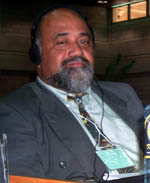

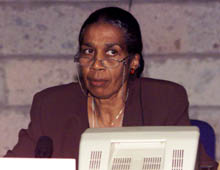

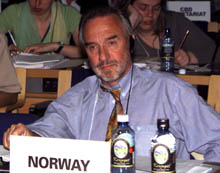

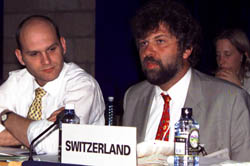




 Ramesh
Ramankutty [
Ramesh
Ramankutty [